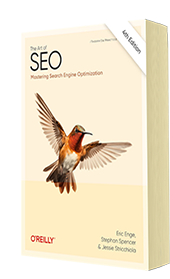Coverage of SES San Jose: Search Algorithms, The Patent Files
I attended the “Search Algorithms: The Patent Files” session first thing this morning. The panelists were Rand Fishkin, CEO of SEOmoz.org, Ani Kortikar, Founder and CEO, Netramind, Dr. E. Garcia of Mi Islita.com, and Jon Glick, Senior Director of Product Search, Become.com. My favorite presentation was from Jon. He was not overly technical (Dr. Garcia lost me at the advanced mathematics talking about calculating dot products of vectors) yet he gave solid advice. Here’s what he had to say, in summary:
Take these patents with a grain of salt, because…
– patent applicants don’t need to use all the stuff they include in a patent application.
– patent applicants don’t have to disclose all of its features in a patent application.
– and they recognize that SEOs and their competitors are pouring over their patent apps.
With that said, there are some valuable learnings from the 2003 Google patent. Search engines may take into account: CTR on your page in SERPs, rapid changes in content, rapid growth of in-links, and length of time users spend on your site.
So which of these actually impact your rankings? Some are red herrings, such as:
– Clickthrough rate (CTR): it’s too easy to distort (e.g. through clickbotting, which is evil and likely to get you penalized). Probably CTR is used for demotion only. In other words, high CTR won’t help your organic rankings, but low CTR may lower your rankings.
– Time spent on a site: when users hit the back button almost immediately, it can signify an irrelevant page or 404 error. However, if this was used then this would in effect reward black hat tactics like mousetrapping and endless pop-ups — tactics that trap users within a site.
– Rate of change in content: Most recent crawl date, last time the content changed, registration date, and first crawl date mostly impacts crawl frequency, not ranking. Duplicate detection technologies are used to find meaningful changes in site content. Meaningful changes in site content do not include putting today’s date or today’s weather on the page — it doesn’t help rankings. When a site changes its IP address, it is often re-evaluated because it is possibly under new ownership.
According to Jon, what’s not a red herring is:
– Rate of change in links: Most Search Engines limit how quickly a site can gain connectivity (sandboxing, link aging). A sudden jump in in-links (e.g. from link farming and interlinking and triangle linking lots of domains) can draw scrutiny. There are exceptions for ?ĺspike?Ĺ sites (editorial review, lots of accompanying news/blog posts, lots of web searches).

Chapter 6:
Keyword Research
From the fundamentals of link building to the nuances of natural linking patterns, virality, and authority.
Related Posts

Embrace Journaling, Tackle Tardiness, and Explore Our Energetic Echo
Here’s what I found inspirational, challenging, or just downright hilarious this week. What caught your eye? And, remember to check out this week’s great podcast episodes: Scaling a SaaS Company with Jason Morehouse “A crucial factor to business success is to find and take the personal path that works best for you.” — Jason Morehouse […]
Read More
Harrison’s harmony, conquering a blank canvas, & gut health hacks
Here’s what I found inspirational, challenging, or just downright hilarious this week. What caught your eye? And, remember to check out this week’s great podcast episodes: Be a Sales Game Changer with Fred Diamond “True elite sales professionals develop a dedicated mindset, proactive client interaction, and continuous self-preparation. They understand their client’s needs and enable […]
Read More
Rebirth of sleeper trains, 4,000 weeks is a long/short time, and golden age for medicine
Here’s what I found inspirational, challenging, or just downright hilarious this week. What caught your eye? And, remember to check out this week’s great podcast episodes: A Story Worth Retelling with Luke Storey “Aligned values are the cornerstone of successful partnerships, whether in business or life, as they shape our moral code, define our priorities, […]
Read More
